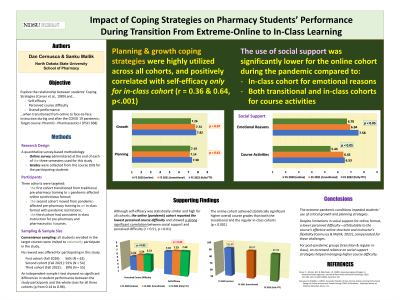Pharmacy Practice
(77) Impact of Coping Strategies on Pharmacy Students’ Performance During Transition From Extreme-Online to In-Class Learning


Dan Cernusca, PhD (he/him/his)
Associate Professor of Practice
North Dakota State University
Fargo, North Dakota, United States- SM
Sanku Mallik, Ph.D.
Professor
North Dakota State University, United States
Primary Author(s)
Co-Author(s)
Objective : The primary objective of this study was to explore the relationship between students' coping strategies and their self-efficacy, perceived difficulty, and overall performance in a pharmaceutics course that transitioned from online to face-to-face instruction during and following the COVID-19 pandemic.
Methods: We analyzed three P1 cohorts in an introductory pharmaceutics course, each experiencing different learning conditions. The first cohort transitioned from traditional pre-pharmacy training to pandemic-affected online synchronous format, the second moved from pandemic-affected training to in-class format with restrictions, and the third had consistent in-class instruction. An online exit survey was administered to assess perceived difficulty, self-efficacy, and coping strategies. Additionally, exam data were collected.
Results: We found that while planning and growth coping strategies were highly utilized across all cohorts (7.2 to 7.8 out of 9), they positively correlated with self-efficacy only for in-class cohorts (r from .36 to .64, p<.001). The use of social support was significantly lower for the online cohort during the pandemic compared to in-class cohorts (p <.05). Although social support did not correlate with self-efficacy, the online cohort reported the lowest perceived course difficulty and showed a strong correlation between social support and perceived difficulty (r=.51, p<.01). Additionally, the online cohort achieved statistically higher course grades (91.4%) than both the transitional (89.6%) and regular in-class cohorts (87.4%).
Conclusions: Our findings indicate that the extreme pandemic conditions impeded students' use of critical growth and planning strategies. Despite limitations in social support due to the online format, a lower perceived difficulty—attributable to the course's effective online structure and instructor’s flexibility—compensated for these challenges. For post-pandemic groups, the increased reliance on social support strategies helped managing higher perceived course difficulty.
Methods: We analyzed three P1 cohorts in an introductory pharmaceutics course, each experiencing different learning conditions. The first cohort transitioned from traditional pre-pharmacy training to pandemic-affected online synchronous format, the second moved from pandemic-affected training to in-class format with restrictions, and the third had consistent in-class instruction. An online exit survey was administered to assess perceived difficulty, self-efficacy, and coping strategies. Additionally, exam data were collected.
Results: We found that while planning and growth coping strategies were highly utilized across all cohorts (7.2 to 7.8 out of 9), they positively correlated with self-efficacy only for in-class cohorts (r from .36 to .64, p<.001). The use of social support was significantly lower for the online cohort during the pandemic compared to in-class cohorts (p <.05). Although social support did not correlate with self-efficacy, the online cohort reported the lowest perceived course difficulty and showed a strong correlation between social support and perceived difficulty (r=.51, p<.01). Additionally, the online cohort achieved statistically higher course grades (91.4%) than both the transitional (89.6%) and regular in-class cohorts (87.4%).
Conclusions: Our findings indicate that the extreme pandemic conditions impeded students' use of critical growth and planning strategies. Despite limitations in social support due to the online format, a lower perceived difficulty—attributable to the course's effective online structure and instructor’s flexibility—compensated for these challenges. For post-pandemic groups, the increased reliance on social support strategies helped managing higher perceived course difficulty.

.png)